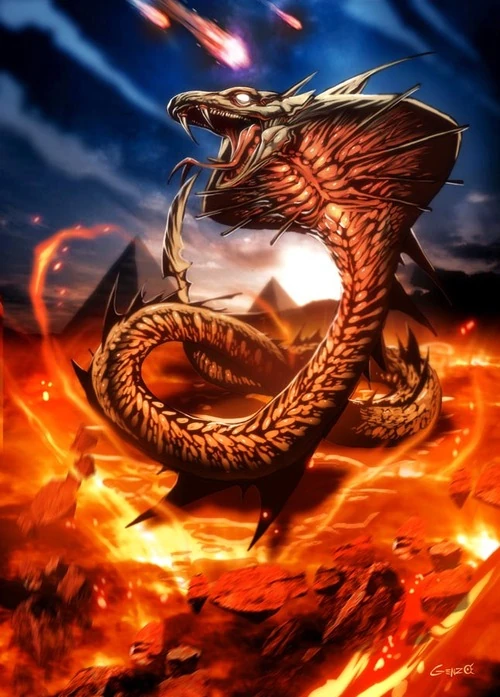From majestic creatures to terrifying monsters, these mythical creatures played an important role in the stories and beliefs of ancient Egypt. We’ll explore the fascinating animals of Egyptian mythology that have left an indelible mark on history and continue to fascinate us till today.
Apep
Apep, in the depths of Egyptian mythology, is the personification of chaos and the eternal adversary of the sun god Ra. This monstrous serpent, often depicted as a giant snake or dragon, lives in the underworld and seeks to devour Ra when he travels through the night. Apep symbolizes the forces of chaos and represents the perpetual battle between order and chaos. The ancient Egyptians believed that priests and pharaohs had an important role in defending Ra against Apep’s attack, emphasizing the importance of their divine duties in maintaining cosmic harmony.

Bennu
Bennu, the mythical bird associated with the sun and rebirth, fascinates with its grace and symbolism. Often depicted as a heron or heron, Bennu is believed to be a manifestation of the sun god Ra or the spirit of Osiris. With its connection to the concept of rebirth, Bennu represents the cyclical nature of life and the eternal renewal of the universe. The myth of Bennu inspired the symbolism of the phoenix in later cultures, making it a creature of profound significance and an enduring symbol of resurrection.

Griffin
The griffin, a legendary creature with the body of a lion and the wings of an eagle, occupies a prominent place in Egyptian mythology. Depicted as the guardian of treasure and protector of the divine, the griffin is a symbol of strength, vigilance, and intelligence. Revered for its majestic form and formidable nature, it is often associated with the sun god Ra and represents the pharaoh’s divine authority. The presence of griffins in Egyptian mythology highlights the ancient Egyptians’ admiration for powerful and noble creatures.

Ammit
Ammit, the fearsome eater of the dead in Egyptian mythology, is an intriguing animal. This creature, with the head of a crocodile, the forelegs of a lion, and the hindquarters of a hippopotamus, resides in the hall of Maat. The purpose of the commit is to weigh the hearts of the deceased against the feather of the maat during the judgment of souls. If the heart is found to be heavier than a feather, Ammit eats it, condemning the person to eternal restlessness. The existence of Ammit underscores the ancient Egyptians’ belief in the importance of a virtuous life and the consequences of one’s actions.

Collar
El Nadda, also known as “the Collar”, is a mythical creature from Egyptian folklore that combines elements of a mermaid and a ghostly spirit. This captivating entity is said to reside in water bodies such as rivers and lakes and lure people into its depths with its enchanting voice. El Nadda symbolizes the allure and danger of water, serving as a vigilante figure in ancient Egyptian culture. Stories of encounters with El Nadda remind us of the importance of respecting and being mindful of the natural forces that surround us.

Aureus
Aureus, a symbol of divine authority and protection, takes the form of a cradled cobra. This sacred serpent adorned the heads of Egyptian pharaohs, representing their connection to the gods and their divine right to rule. Uraeus also acts as a protector against malevolent forces, instilling fear in the hearts of potential adversaries. Its presence emphasizes the important role of the pharaoh as a mediator between the mortal and divine realms and demonstrates the ancient Egyptians’ belief in the power of divine protection.

Typhon
Typhon, a terrifying monster with the head of a crocodile and the body of a snake, is a symbol of chaos and destruction in Egyptian mythology. Often depicted as a giant creature, Typhon represents forces of nature that can wreak havoc on the world. The ancient Egyptians believed that the god Seth fought against Typhon to preserve order and stability. Typhon’s existence is a reminder of the precarious balance between creation and destruction, emphasizing the need to maintain harmony and guard against chaos
.

Sobek
The crocodile god “Sobek”, is a prominent figure in Egyptian mythology. With his terrifying appearance and association with the Nile, Sobek is both revered and feared. The Egyptians believed that Sobek’s authority over the annual flooding of the Nile River was vital to their agricultural prosperity. As a deity, Sobek is a symbol of power, fertility, and protection. Their worship reflects the profound importance of the Nile and its ecosystem to ancient Egyptian society and underlines their reverence for the natural world and the forces that sustained their civilization

.
Seropard
A hybrid creature with the body of a leopard and the long neck of a serpent, “the serpent part” finds its place among the fascinating beasts of Egyptian mythology. Often depicted in ceremonial art and as a symbol of royal power, the serpent represents the fusion of land and water, earth and sky. This mystical creature symbolizes the ancient Egyptians’ respect for the interconnectedness of the various spheres and the harmonious balance they must achieve. Seropard’s imagery is a reminder of the complex relationship between different aspects of life and the search for balance.

Sphinx
The mystical Sphinx, with its human head and lion’s body, stands as an iconic creature of Egyptian mythology. Serenely towering over the entire desert, the Sphinx is a symbol of wisdom, guardianship, and mystery. Often associated with the pharaoh and the sun god Ra, this monumental creature is the essence of divine power and wisdom. The Riddle of the Sphinx, as depicted in mythology, reflects the ancient Egyptians’ emphasis on the intellectual prowess and challenges they faced to achieve enlightenment.

